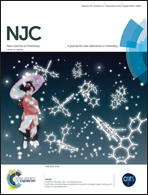Lanthanide metal–organic frameworks based on the 4,4′-oxybisbenzoic acid ligand: synthesis, structures and physical properties†
Abstract
A series of lanthanide microporous coordination polymers, namely, {[Ln4(OBA)6(DMF)(H2O)]·2DMF·3H2O}n [Ln = Nd(1), Sm(2), Eu(3), Gd(4)]; {[Ln4(OBA)6(H2O)2]·3DMF·2H2O}n [Ln = Tb(5), Dy(6)]; {[Ln4(OBA)6(DMF)(H2O)2]·2DMF·4H2O}n [Ln = Tb(7), Dy(8)] (H2OBA = 4,4′-oxybisbenzoic acid, DMF = N,N′-dimethylformamide), have been successfully prepared via solvothermal methods and characterized by FT-IR, photoluminescence spectra, thermogravimetric analysis (TGA), powder X-ray diffraction (PXRD) and single-crystal X-ray diffraction. All of the lanthanide coordination polymers showed three dimensional (3D) metal–organic frameworks. The structural variations in compounds 1–8 may be caused by lanthanide contraction and different coordination modes of V-shaped H2OBA ligands. The luminescence properties of compounds 3, 5 and 7 have been studied in the solid state at room temperature, and all of them displayed metal-based luminescence. Moreover, compounds 4, 6 and 8 exhibited antiferromagnetic coupling within the carboxyl oxygen bridged rare-earth chains.


 Please wait while we load your content...
Please wait while we load your content...